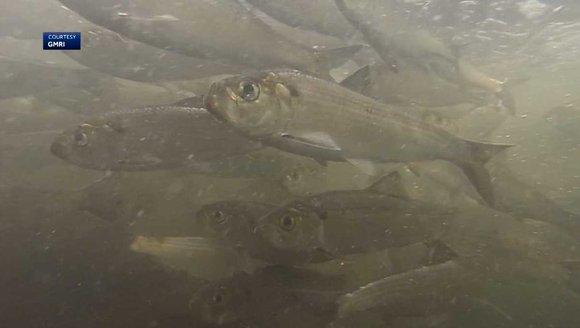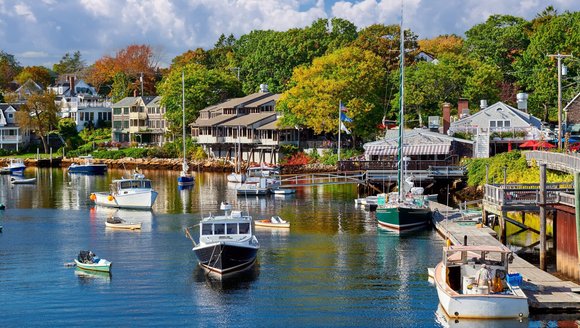The Alewife Journey: A Conservation Success Story
Perspectives | Apr 17, 2025
On a spring evening at the Gulf of Maine Research Institute, guests gathered for the premiere of a film celebrating one of Maine’s most remarkable seasonal phenomena: the migration of the alewife.
Following the screening, a panel of four local experts — two from GMRI and two from the Presumpscot Regional Land Trust — offered reflections that brought rich ecological context, local success stories, and plenty of personal passion to the discussion.

A Fish That Brings the Ocean Inland
GMRI Research Associate Sam Bengs opened the panel with an engaging look at the biology and historical importance of alewives, a type of river herring known for their annual migration from the ocean to freshwater rivers, lakes, and ponds.
"These fish are just a packet of nutrients. They're very oily, so they're a great meal for mammals, birds, other fish — and they bring ocean nutrients into freshwater systems."
Samantha Bengs Research Associate
These freshwater systems and the surrounding forest and land ecosystems rely on that influx of nutrients that alewives bring each spring during their migration run. If these migrations stop, it’s not just the alewives who suffer, it’s the birds, the seals, the harvesters, the trees that all depend on this nutrient delivery.

Restoring the Watershed, One Brook at a Time
Toby Jacobs, Program Manager at Presumpscot Regional Land Trust, shared how conservation in action plays a vital role in supporting alewife migration. He recounted the growth of Mill Brook Preserve, a beloved stretch of green space in Westbrook that also happens to be key habitat for migrating alewives. This growth, though, would not be possible without the dedicated efforts of volunteers and passionate communities who work to keep these migration pathways open to our spring visitors.
"Every spring, we walk the brook with volunteers to clear just enough blockages for the alewives to get through. It’s about keeping their path open while respecting the balance of the whole ecosystem, including the other fish and beavers who depend on those blockages."
Toby Jacobs Program Manager Presumpscot Regional Land Trust
The land trust’s work goes well beyond preserving green space. They also manage the Highland Lake Dam fishway and coordinate a community-led fish count to monitor the run's strength. It’s a community-powered success story rooted in care and stewardship.
Climate Change: A Rare Bit of Good News
While climate change spells trouble for many marine species, GMRI Senior Scientist Graham Sherwood offered a rare positive update: alewives, so far, appear to be doing quite well.
"In the last decade, we've seen about a threefold increase in landings, and not just in Maine’s rivers — we’re seeing them establish runs in new areas."
Graham Sherwood, Ph.D. Senior Scientist
Why are they thriving when others aren’t? Graham explained that alewives may benefit from being at the midpoint of their geographic range, giving them greater resilience as waters warm. He added that decreased pressure from declining predators and reduced competition with struggling species like Atlantic herring could be giving alewives a leg up in their recovery. They’ve also been able to spread out their runs so that while a run further north might suffer one year, they might do exceptionally well further south that year, or vice versa. In a sense, they are hedging their bets.
"It's one of those rare success stories that we don't get to tell very often."
Graham Sherwood, Ph.D. Senior Scientist
Conservation That People Can Feel
Will Sedlack, Executive Director of the Presumpscot Regional Land Trust, brought a human perspective to the panel, emphasizing how seeing nature in action — like the alewife run — can inspire deeper community commitment.
"When people can get out every spring and see that migration, they’re willing to go to bat for conservation, they’re willing to say this is something we should value as a community and work to protect."
Will Sedlack Executive Director Presumpscot Regional Land Trust
He linked this direct engagement with local ecosystems to better climate action and land-use planning. It’s not just about saving fish — it’s about building towns where people and ecosystems can thrive together.

A Legacy of Curiosity and Commitment
From the mysteries of fish homing behavior to the hopeful signs in river data, the evening left attendees with a deeper appreciation for the intersection of science, conservation, and community. And it reminded us that the migration of a small fish can be a big story — about resilience, recovery, and the power of local action.
If the evening proved anything, it’s that the story of alewives isn’t just a story about fish—it’s a story about people: researchers, volunteers, town leaders, and citizens all working together to reopen the pathways that nature knows by heart.
If you want to see the migration in action, we'd recommend downloading the Alewife Migration Viewing Guide and taking a self-guided tour through Mill Brook Preserve in late May or early June.
Alewife Migration E-Guide
We're excited to offer you the Alewife Migration Guide. This guide was developed in collaboration with Presumpscot Regional Land Trust and allows you to embark on a self-guided tour of the alewife migration through Mill Brook Preserve. Whether you're a seasoned naturalist or a curious observer, you'll find valuable insights into alewife ecology, viewing protocols, and more.
Watch the Film: The Alewife Journey
Follow the incredible migration of alewives as they journey from Casco Bay up the Presumpscot River, navigating through Mill Brook to reach Highland Lake. This video captures a guided educational walk hosted by the Presumpscot Regional Land Trust, offering a fascinating look at one of Maine’s most important seasonal wildlife events. Thank you to Casco Bay Estuary Partnership for their funding support of this film.



